- Home
- News & Features
- News
- FY2019
- The “Grand Egyptian Museum” attracting attention from around the world: Construction, preservation and restoration projects underway for the opening of the museum in 2020
News
February 6, 2020
The “Grand Egyptian Museum” attracting attention from around the world: Construction, preservation and restoration projects underway for the opening of the museum in 2020
In Egypt, construction of the Grand Egyptian Museum (GEM) is now proceeding at a rapid pace with a target for opening in 2020. In addition to the construction of the GEM, which will become the world’s largest museum dedicated to a single civilization, JICA has been providing multifaceted cooperation for a wide range of projects, such as research, analysis, preservation, and restoration of a number of important ancient Egyptian monuments including the treasures of King Tutankhamun to be stored in the museum. JICA is also providing support in areas related to human resources development, organizational structure and operational planning.
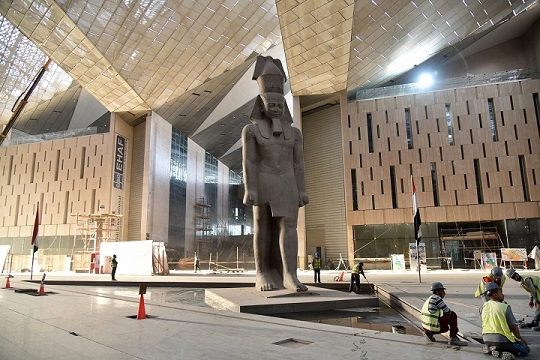 Grand Egyptian Museum (GEM) under construction near the three Great Pyramids of Giza in Egypt. The conservation work for the artifacts is being conducted at the Grand Egyptian Museum Conservation Center adjacent to the museum (Photo courtesy of GEM/EHAF Consulting Engineers)
Grand Egyptian Museum (GEM) under construction near the three Great Pyramids of Giza in Egypt. The conservation work for the artifacts is being conducted at the Grand Egyptian Museum Conservation Center adjacent to the museum (Photo courtesy of GEM/EHAF Consulting Engineers)
Japan’s state-of-the-art science makes progress in elucidating the mysteries of ancient Egypt
“The Tutankhamun tomb was discovered 97 years ago in 1922, by British archaeologist Howard Carter, in the Valley of the Kings in Luxor, Egypt. About 5,000 burial artifacts have been discovered, but approximately 70% have yet to be properly analyzed scientifically.” This was revealed by Professor KAWAI Nozomu of the Institute for Frontier Science Initiative, Kanazawa University, a specialist who has been studying related projects for Grand Egyptian Museum for many years.
Over the years from 2008 to 2016, JICA has been implementing projects related to the Grand Egyptian Museum with the main objective of supporting human resource development at the Grand Egyptian Museum Conservation Center established by the Egyptian government. The mandate of the Center is not only limited to the conservation of artifacts for the Grand Egyptian Museum, but also to become an international hub for the conservation of cultural properties and promote the continuous development of human resources throughout Egypt.
Initially from 2008, JICA’s project provided training to local conservators and scientists on preventive conservation utilizing elaborate replicas. To date, JICA has dispatched more than 180 experts and provided training to a total of 2,250 trainees. Today, there is an increasing number of presentations by trained Egyptian conservators and scientists to international academic conferences and academic journals.
In 2016, the Grand Egyptian Museum Joint Conservation Project (GEM-JC) was newly launched to start the actual conservation of genuine artifacts. Experts have joined from the Japan International Cooperation Center (JICE) and the Tokyo University of the Arts, and to date, Egypt and Japan are working together to conserve important artifacts, including those of King Tutankhamun.
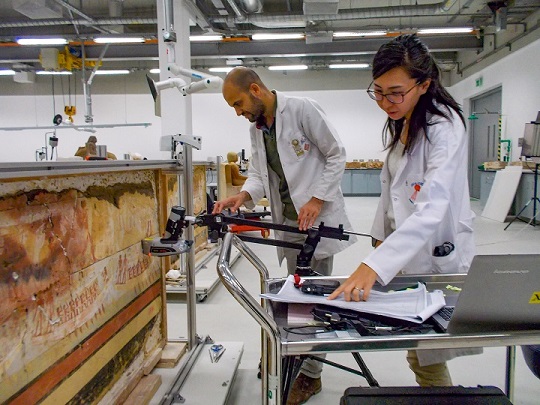 Conservation work at the Grand Egyptian Museum Conservation Center. The non-destructive diagnostic analysis of murals using high-resolution digital imaging microscopy contributes not only to understanding the state of preservation of the work from the past but also to acquiring new archaeological findings (Photo courtesy of GEM/JICA)
Conservation work at the Grand Egyptian Museum Conservation Center. The non-destructive diagnostic analysis of murals using high-resolution digital imaging microscopy contributes not only to understanding the state of preservation of the work from the past but also to acquiring new archaeological findings (Photo courtesy of GEM/JICA)
Japan’s know-how leveraged in every aspect from human resource development to conservation
The GEM-JC Project encompasses all processes of artifact conservation, from the investigation of the present condition of the artifacts, temporary treatment before transportation, packaging and transportation from the original location to the Conservation Center, to conservation work at the Center.
From a wide range of display candidates, 72 artifacts were selected from three categories: “mural paintings and stones,” “textile,” and “wooden artifacts,” that were considered essential for the museum’s opening. The candidates were divided into 10 "lead artifacts," which were jointly conserved by Japanese and Egyptian experts, and 62 "follow artifacts," which were mainly conserved by Egyptian experts.
The transportation of wooden artifacts to the Conservation Center was conducted with the cooperation of Nippon Express Co., Ltd., which has a proven track record in transportation of artifacts and cultural heritages. Each artifact was protected by facing with traditional Japanese washi paper to prevent the gold leaf from peeling off due to vibration. Various analyses at the Center utilize Japan’s expertise, including technologies and experience, such as non-destructive inspections of Japanese Buddhist statues using state-of-the-art equipment.
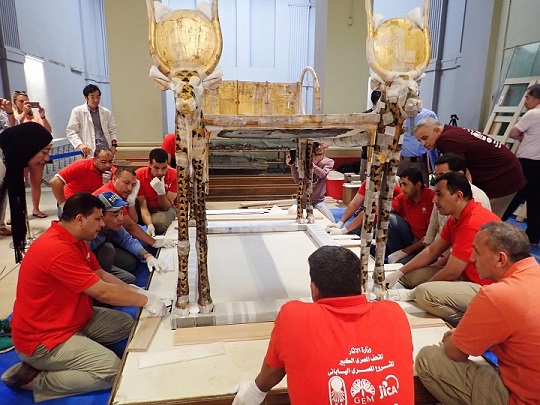 Packaging and transportation of King Tutankhamun's ritual bed. This project was carried out in cooperation with Nippon Express Co., Ltd., which has expertise in the transportation of precious cultural heritages (Photo courtesy of GEM/JICA)
Packaging and transportation of King Tutankhamun's ritual bed. This project was carried out in cooperation with Nippon Express Co., Ltd., which has expertise in the transportation of precious cultural heritages (Photo courtesy of GEM/JICA)
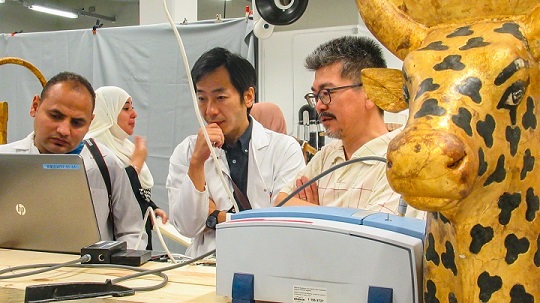 Works at the Wood Lab. Using a portable FTIR and RAMAN spectrometer, JICA experts conducted a non-destructive analysis of King Tutankhamun’s ritual bed (Photo courtesy of GEM/JICA)
Works at the Wood Lab. Using a portable FTIR and RAMAN spectrometer, JICA experts conducted a non-destructive analysis of King Tutankhamun’s ritual bed (Photo courtesy of GEM/JICA)
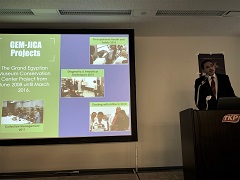 A symposium was held in Kyoto in September. Many fans of Egyptian archaeology filled the venue
A symposium was held in Kyoto in September. Many fans of Egyptian archaeology filled the venue
Against this backdrop, a symposium entitled “Preserving Pharaohs' Treasures 2019” was held in Kyoto in September, and in Tokyo in October, to present the recent progress of the project. More than 250 fans of archaeology listened attentively to the presentation at the Tokyo venue.
At the symposium in Kyoto, following Dr. Hussein Kamal’s keynote speech, experts in each field provided briefings and reported on the new facts that have come to light in recent work. Textile excavated from Tutankhamun’s tomb were severely degraded, but even under such adverse conditions, analytical research using high-definition digital microscopes and ultraviolet photograph was able to reveal that the underwear (like a Japanese “fundoshi”) was made of a fine and high-quality weave, and that the main parts of chariots were made of elm tree wood, which did not grow in Egypt at the time. These and other interesting new facts were introduced one after another.
The last mile towards opening
At the end of the symposium, Mr. NAKAMURA Mikio, Chief Advisor for the GEM-JC Project, showed his enthusiasm towards the opening of the museum.
A huge number of artifacts, including the Tutankhamun Collection, will be stored at the Grand Egyptian Museum, of which approximately 50,000 are expected to be displayed in the Tutankhamun Exhibition Area and some others. In addition to Arabic and English, descriptions will also be written in Japanese in honor of Japan’s contribution.
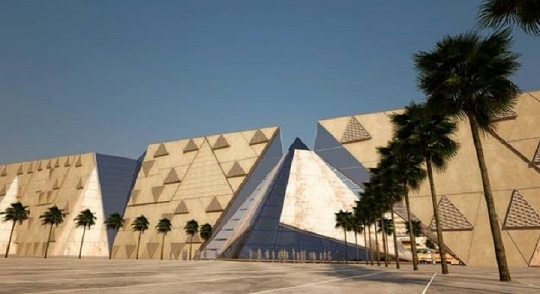 Computer graphic image depicting the exterior of the completed Grand Egyptian Museum scheduled to open in 2020. It is expected to make a major contribution to the development of Egypt, including culture, tourism, and employment (Photo courtesy of GEM)
Computer graphic image depicting the exterior of the completed Grand Egyptian Museum scheduled to open in 2020. It is expected to make a major contribution to the development of Egypt, including culture, tourism, and employment (Photo courtesy of GEM)
At present, in parallel with the GEM-JC Project, there is support for the conservation of the “Khufu's Second Boat” to be displayed at the museum. The development of the “Cairo Metro Line No. 4” that connects the capital city of Cairo to the vicinity of the museum is also being planned. JICA will continue to support the establishment of Egypt's unique affluence and identity by cooperating in the protection and dissemination of ancient Egyptian culture, and continue its economic development cooperation centering on the important tourism industry.
Related Links
- About JICA
- News & Features
- Countries & Regions
- Our Work
- Thematic Issues
- Types of Assistance
- Partnerships with Other Development Partners
- Climate Change / Environmental and Social Considerations
- Evaluations
- Compliance and Anti-corruption
- Science and Technology Cooperation on Global Issues
- Research
- JICA Development Studies Program / JICA Chair
- Support for the Acceptance of Foreign HRs / Multicultural and Inclusive Community
- Publications
- Investor Relations





